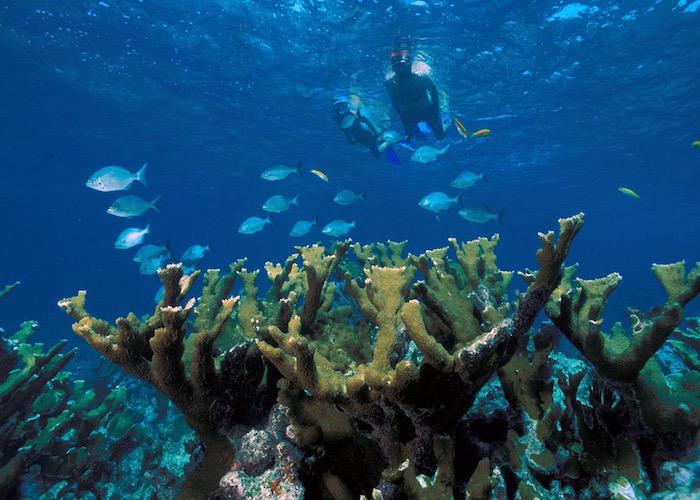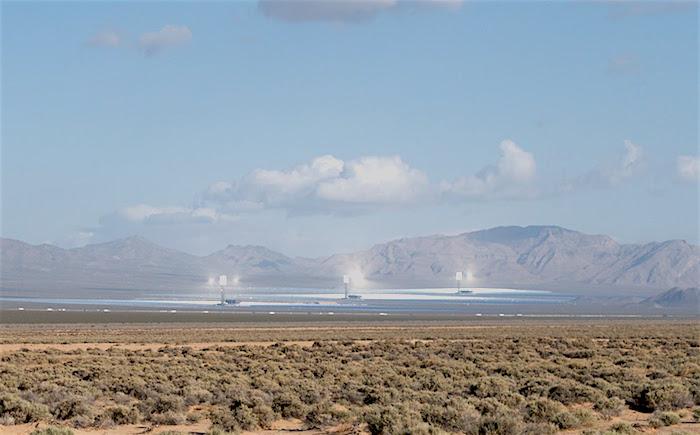President Obama's Public Lands Legacy
The Obama administration likes to tout that the president has protected nearly 550 million acres of public lands during his tenure, but observers say that number tells an uneven story of President Obama's environmental legacy, and add that the Democrat can and should accomplish much more before he leaves the White House.
Since he took office in 2009, the president has turned to the Antiquities Act to create, or enlarge, nearly 30 national monuments, and has pushed for an aggressive overhaul of the nation's energy sources from fossil fuels to solar and wind power. But in this, the National Park Service's centennial year, some national park advocates believe President Obama could have done more for the parks -- and still can -- and has missed opportunities to truly bolster conservation initiatives within the National Park System.
There have been concerns over the U.S. Fish and Wildlife Service's push to delist grizzly bears in the Greater Yellowstone Ecosystem, the threat a major power transmission corridor poses to Colonial National Historical Park in Virginia, seeming delays in rulemaking for a marine reserve at Biscayne National Park in Florida, oil exploration at Big Cypress National Preserve in Florida, pollution risks to Voyageurs National Park in Minnesota posed by sulfide mine leases in the Rainy River Watershed, and other clean air and water, wildlife, and stewardship issues across the country.
Too, the administration has drawn criticism for proposing to build solar energy plantations uncomfortably close to the park system. While there was a crescendo buildup to the National Park Service's 100th birthday, was there enough substance behind it? That's not a question to overlook. While there was great effort to bring more people out to the National Park System, an effort that succeeded in total visitation if not at every park unit, how much time was spent on girding the National Park Service's conservation mission? Exploring for oil in Big Cypress? Expanding a transmission line corridor through Delaware Water Gap National Recreation Area and across the Appalachian National Scenic Trail? Allowing the "bombing" of parts of Yellowstone National Park to protect snowmobilers from avalanches?
Back in July, as part of Traveler's Centennial Series of essays, Dr. John Lemons, Emeritus Professor of Biology and Environmental Science in the Department of Environmental Studies at the University of New England, questioned how much effort the agency was investing in actually conserving the National Park System. To buttress his point, he cited to what some would argue is overdevelopment of the Yosemite Valley and to the allowance of snowmobiles in Yellowstone National Park.
"Not only do the examples of Yosemite and Yellowstone help to weaken the strong preservation of the NPS discussed above, but they also show the deep division between preservationists and other users of national parks," wrote Dr. Lemons before concluding that, "(T)he purposes of national parks continue to be debated, those who value the natural resources and scenery of national parks need be mindful of legal interpretations of the Organic Act, of what is actually happening in national parks, but also of the task of conservation education that others remind us. It might be somewhat naive to believe national parks can be saved from development and use. Yet, national parks are the embodiment of an ideal about Americans’ relations with nature and although difficult to achieve the ideal is worth believing in."

Environmental groups think the Obama administration should have worked harder to prevent oil exploration in Big Cypress National Preserve/NPS
From where he sits, President Obama has wide latitude to affect the National Park Service's conservation mission. And while the sheer acreage that he has touched through the Antiquities Act gains attention, might he have done more?
"We just weren’t seeing the centennial plans develop in a way that would lead to powerful conservation," said Mark Wenzler, senior vice president of conservation programs for the National Parks Conservation Association. "Every Kid in A Park and diversity and getting more visitors, all good stuff that we agree with. But we also felt that this was an opportunity to secure a long-lasting conservation outcome for the parks."
While NPCA was pleased to see the president greatly expand the boundaries of the Papahanaumokuakea Marine National Monument in the Pacific Ocean and the Northeast Canyons and Seamounts Marine National Monument in the Atlantic Ocean, when it comes to the National Park Service specifically, Mr. Wenzler believes the administration fell short.
“It personally kind of riled me a little bit that you’d ask them, ‘What are you doing specifically for the national parks?', and they talk about all these marine monuments that they created in remote parts of the Pacific. That’s great, we like that too, but, first of all, they’re not national parks, so I kind of feel like they kind of dodged the question about what are they doing specifically to advance long-term protection and conservation of the national parks in this centennial," the NPCA official said. "We’re grateful for all the other things that the administration has done, on climate and marine monuments, but if you just focus the queston on national parks, we think that there’s a bigger opportunity."
Among the actions NPCA would like the Obama administration to tackle before the president leaves office:
* Commence work on an Environmental Impact Statement that could lead to better protection for Big Cypress National Preserve from seismic testing for oil drilling, and adopt a Backcountry Access Plan for Big Cypress that prevents ORVs from destroying wetlands and designates 200,000+ acres of wilderness to protect Florida panthers;
* Withdraw national forest land from mineral development and hard rock mining along Yellowstone National Park’s northern boundary;
* Protect the health of the Colorado River’s nine national parks by redirecting a portion of the Colorado River Basin Fund to support research that defines and promotes adaptive water management, and;
* Set national parks on the path to clean air, cut climate pollution, and protect public health by strengthening the Regional Haze Rule.

A marine reserve proposed for Biscayne National Park is in limbo until the National Park Service can go through a rulemaking process for the area/NPS
Interior Department staff are aware of these issues, and there is "work on each of these priorities and work on their progress is ongoing," Interior spokeswoman Jessica Kershaw said, though she would not speculate on when any details of those efforts would be ready to be made public.
While this list might seem overly park-centric for any administration in its closing days, let alone President Obama, Mr. Wenzler points out that 2016 does mark the 100th birthday of the National Park Service, a significant milestone that drew hundreds of millions of visitors to the National Park System this year and generated untold publicity from the media.
“I think that’s a perfect example of what happens if you’re not getting the kind of attention from the White House that you should be," he replied when we discussed where the Park Service was on the requisite rulemaking needed to enforce the marine reserve created in principle at Biscayne National Park in June 2015. "Understand, if this were any ordinary year, the White House isn’t going to be involved in Biscayne marine reserve rulemaking. But if it’s the centennial of the National Park Service and you want to have a legacy, and you want to create a good legacy for the Park Service, maybe you pay a little extra attention to what’s going on in the National Park Service.
"And maybe you ask more questions and put some more pressure on people to get things done so that you can say at the end of the day these are all the amazing things that we’ve done for our national park," he said. "My fear is they’re going to leave stuff on the table that they could have gotten done.”
Other observers see President Obama as making strong strides for the environment and public lands, but perhaps not as good as he might have.
"My views on Obama may be shaded by the fact that he's looking great compared to the alternatives we have in this coming election, but my sense is that his public lands legacy has improved during the course of his administration," said Bill Lowery, a professor at Washington University in St. Louis who focuses on American politics, public policy, and natural resources. "His behavior lately reminds me of how President Clinton became more aggressive in his second term.
"More specifically, I like how he expanded the Pacific marine monument and just recently created the one in the Atlantic. Both were somewhat controversial in some quarters, so I appreciated his willingness to act anyway," Professor Lowery continued. "The possibility for alternative uses (including energy development) on some of the new and existing public lands does temper too much enthusiasm, but then again as we all know, a president alone can only do so much. My guess is that he will declare the Bears Ears National Monument soon, but I wouldn't be surprised if he waits until after Nov. 8."
Dr. Alfred Runte faults President Obama for not being more proactive.
"First, there is no environmental 'legacy,'" said Dr. Runte, author of National Parks, the American Experience, and Yosemite: The Embattled Wilderness. "Better said, what is President Obama’s 'record' on the environment, and here I stand with Otis Graham (American Presidents and the Environment). There is nothing 'distinctive' in the Obama administration that would lend itself to a 'legacy.' More than environmentalists, he has been swayed by his past—specifically his interests in community organizing on behalf of civil rights. He would rather play golf than visit a national park. He is a 'city kid' who happened to be elected president in a time of dwindling national leadership.
"Yes, the national monuments are a numbers game meant to organize an environmental base. But he doesn’t believe in that base. It gets in his way, after all, especially when it sues for compliance regarding laws he would prefer to ignore. The Endangered Species Act heads that list," continued Dr. Runte. "Each time, he has gone to the Federal Register to get around it, and each time the courts have held him back, i.e., permission to grant wind farms a legal 'take' of eagles. I believe the comment period on the latest attempt just ended.
"Meanwhile, national monuments left in the hands of BLM can hardly be considered 'protected.' It’s just not BLM’s mandate, no matter what the 'proclamation' says. How much nibbling, development, etc., will still go on adjacent to those monuments? At least the Forest Service, having fought for a century with the Park Service, mildly protects park boundaries. I doubt we will see any of that give and take at BLM, especially with recent mandates (Obama’s) to develop wind and solar wherever feasible. It’s not just the proclamation; it’s also how the management agency 'interprets' the proclamation, and whether the president and/or Congress even notice."

The Ivanpah Solar facility located southwest of Las Vegas "stands to destroy valuable desert tortoise habitat near Mojave National Preserve while also impacting the viewshed," the National Parks Conservation Association said in a 2012 report.
At the University of Montana, Professor Bill Borrie gives the president credit for his actions on the two marine monuments, but dings him for his outwardly hands-off approach with the Interior Department.
"He must take some responsibility for the leadership within the Department of Interior. (Interior Secretary) Sally Jewell’s actions can be interpreted as the increased commercialization of our national parks, and the concerns about sexual assault under Jon Jarvis’ leadership are incredibly important. The Sports Illustrated photo shoot in Yellowstone is particularly egregious, but it is only one of many interesting decisions," said Professor Borrie, who teaches park and recreation management.
"Further, I question the role of the 'Find Your Park' campaign and what that has achieved to 'promote and regulate the use of the federal areas,' he added. "Has it been concentrated in high-use areas (creating traffic jams, etc.), or has it been encouraging/facilitating a reflective form of recreation (as Joseph Sax long ago called for). I also ponder the status of science, both natural and social science, in Obama’s administration."
At Boise State University, Professor John Freemuth, the executive director of the Cecil D. Andrus Center for Public Policy, said the number of protected acreage bandied about by the Obama administration "is indeed a numbers game."
"The U.S. is second only to France in the amount of ocean acres it can claim...ie. we both have a hell of a lot of islands," said Professor Freemuth. "If you have the time it would do well to examine the proclamations to see what's actually changed in terms of 'management.' I don't think any of it is a bad thing, it's just spun a bit in terms of the ocean monuments. I actually supervise a USGS grant where we try and categorize levels of protection for protected areas. We can't give certain monuments the same category if they allow for all sorts of multiple uses in the proclamation or statute."
The professor did say the president "deserves more credit for some of his historic and cultural monuments. It allows NPS to try and tell a more complete American story, warts and all, and that's an encouraging thing."
Passage of time is the best filter through which to judge a president's actions, and that likely will be the case with President Obama and the environment. Whether he bolsters his record, or legacy, in the remaining three months remains to be seen.


Comments
The environmental movement has some great leaders, bigger than Trump! That's why we still have the 1872 mining law. It's why the Elliott State Forest in Oregon is about to be sold.
Yes, President Obama is to be given credit or creating these National Monuments but this is the easy part. The real question is how he plans to pay for them. Where are the staff and money needed to care to the newly created National Monuments? It seems that this question will be left to the person who follows President Obama in office. I assume there is a plan to address this issue, at least I hope so.
Obama, like his predecessors, did little to help land management agencies. They're all critically under-funded; and hiring and promotion is by politics rather than ability. The country needs to bring back Civil Service exams; and it needs to increase funding substantially - to the order of 20+ billion dollars. Those agences run almost entirely on volunteers now.
Land management agencies are far from running "almost entirely on volunteers now"! That said, if not for volunteers, many front-facing, recreation-related tasks would disappear, or...?
President GW Bush preserved far, far more acres than President Obama has, through the Antiquities Act (of course the liberal in me snarkes that most of them exist underwater.) True that the President has 60 or so days left, but I'm not confident. Having spent time in Southeast Utah, I would love to see Bears Ears come to fruition at the minimum.
And staffing new units is left to Congress not the President, Harryb. The President proposes a reasonable budget and hopes for the best. My experience has been that despite public spats and nasty press releases during and after the establishment of new monuments, from opposing members of Congress, the funding usually comes through.
Now we can drain the swamp of these lying delusional progressive fantasies! We can make our Parks great again!
If you were to visit the Great Smokey Mountains National Park, a notice appears on the sign, announcing the park's entrance. Notice: "An Iinternational Biosphere Reserve". President Obama's 550 million acres, are now under the United Nation's: "World Network of Biosphere Reserves ( WNBR ). 669 Biosphere Reserves in 120 countries, including 16 trans-bound sites. President Obama's 550 million acres, is the product of his 23 proclamations. The key is: International Biosphere Reserve. All of the U.N's efforts are governed by International Law.
Knowing the History of the League of Nations, and the United Nations, causes me great concern. Example: Toward the end of the first world war, when the Middle East was controlled by the Ottoman Turks: The British and French conquest, took the land from the Ottoman Turks. The League of Nations and the United Nations stepped in, and created a British Mandate and a French Mandate. These two mandates divided up the Middle East. It's the U.N. that continues to create conflict in the Middle East, contrary to their talk of peace in the Middle East.
Conflict in the Middle East preceeded the UN by a couple of thousand years. Somehow I don't really think the UN is going to come in and claim the Great Smokey Mountains National Park.
No, their intent if far more nefarious than that. But you are correct about them middle east. Nice to know that you are aware the unrest there isn't the fault of the US.